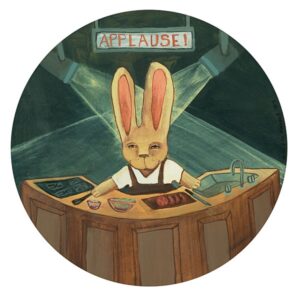You’re really going to rent scaffolding to paint the vaulted ceiling in your Great Room? Before you start painting through the blades of your ceiling fan, educate yourself about what makes for a top-notch paint job. Oregon Home asked two interior designers and three professional painters for inside info about homeowners’ typical brushes with paint. Man, they let it roll!
[1. Spend money on the services of a professional painter when your house—or schedule—demands it.]
If your house includes vaulted ceilings or lots of eaves and odd-sized nooks and crannies, consider hiring a painting contractor to take on your interior painting. Don’t rule out hiring a professional painter until you get some estimates and compare it against how many hours it will really take you to transform a room. While your home’s tall straight walls may look easy to paint, they’re actually not. Painting an 18-foot-tall wall takes equipment most homeowners don’t have. “A lot of the challenges with today’s homes are safety-related and height-related,” says Brian Hoge, the owner of Brian Hoge Painting in Hillsboro, Ore., who’s been in business for 28 years. “Now, my crew and I deal with 16- and 18-foot entryways with staircases and vaulted ceilings. People don’t always have the ladders and equipment for painting that high up. Plus, it can be dangerous to be up that high if you don’t know what you’re doing.”
[2. Update trim colors and the ceiling color when you change wall color.]
This is especially important when you opt for dark colors such as the browns, maroons and dark terra-cottas at the bottom of paint strips. With these shades, white trim can look too stark. “If a room’s walls will be painted in a really dark color, don’t use a white on the ceiling,” says Brenda Miller of Brenda Miller Interior Design in Portland. “Bring the ceiling color closer to the wall color. I’ve found that colors that have a little yellow or a little gray in them can work well on a ceiling. Homeowners often overlook ceiling colors and don’t give them the time and attention they deserve, but the color of your ceiling often makes or breaks a room.”
If you’re just repainting walls the same color or are staying within the same color family, you can often get by with just painting the walls. “A lot of times you can get away with ‘updating’ the wall color,” says Hearst. “You can paint the walls five or six times before you really need to repaint the trim. The trim should last 10 or 20 years.”
[3. When you select wall colors, don’t stay in the band of the color wheel that you’ve stayed in for the last 20 years.]
Be bold; it’s only paint. You can always repaint a wall if you can’t stand the way it looks. Work with a color consultant if you’re aware that you’re among the color-challenged or if you just want to end up with a great designer space. “I’m seeing a lot of bold splashes of color with warm tones,” says Hoge.
Whatever you do, don’t choose an outlandish or wild color just to make a statement. “With paint, people aren’t going to always change it every two years,” says Rachel Brodkey of Rachel Brodkey Painted Environments in Portland. “I encourage my clients to choose colors they want to live with for a while. You can’t be too bold or too subtle. It comes down to your personality and how it fits with the space.”
[4. If your child wants a room covered in zebra stripes, don’t give in to his or her whims.]
There’s a better way to combine the need for new paint with your child’s desire of the moment. Kids are often enthusiastic about decorating their rooms and can have ideas that are, well, not always feasible. The problem is that their tastes can change so quickly that their latest, most favorite color can turn into their most hated before the walls even dry.
“Kids will say, ‘I want red room,’ or, ‘I want hot pink walls,’ but kids grow and change, and two months later they may decide red isn’t their favorite color any more,” says Miller. “Paint their room a color such as camel or a color that gives the room a kind of warm golden-glow feeling, and let them have bright red pillows or a red lamp. Let the things they pick out be the Color of the Moment. They’ll like their room, and you’ll be able to live with it as well.”
{mospagebreak}
[5. Just because you find a color you think is great doesn’t mean you should use it to paint A room.]
Think about the color in the large context of what kind of room it will be in, how you plan to use the room and how you feel about the color. Figuring out which color to paint a room can be tricky. You may like a particular color, but it may not be a color that will draw people into using the room. “When I work with clients, I like to figure out what kind of colors make them feel good,” says Miller. “I do that because I’ve found that how a room makes you and your family feel is really the most important reason to decorate a room. If the room feels pleasing, you’ll use and enjoy the space. You know that bumper sticker that says a mind is a terrible thing to waste? Well, sometimes I feel that way about a room. You’ll see a beautiful room and people will stop in the doorway to admire it, but they have no desire to walk into it because it doesn’t feel welcoming.”
[6. Don’t use a roller to Paint trimwork.]
While you can spray or use rollers on woodwork and moldings, most professionals recommend using a brush to paint trimwork. “I like woodwork to be brushed, and that’s an art,” says Miller.
“It’s going to add to the expense, but it also gives a room soul. You can tell that a human worked on it. When you spray paint onto a surface, you end up with a perfect look. When paint is brushed on, you have the difference between a handmade piece of antique furniture and just a piece of furniture. You particularly notice brushwork on kitchen cabinetry: It has a warmth a spray finish doesn’t have. Of course, a budget doesn’t always allow for that, so selecting great colors is important.”
[7. Realize that a paint job is only as good as the prep work underneath it.]
Sure, it’s exciting to gather paint chips and settle on a wall color, but you’re sabotaging the result if you start rolling on the new wall color before you’ve thoroughly prepped the room. “Good prep is the best way to a very clean job,” says Brodkey. “Filling holes in the walls, and cleaning, dusting and wiping down walls are all important. In a kitchen or a bathroom the walls need to be washed down because rooms that have water and steam often develop a film on the walls.”
While it may be tempting to paint around switchplates and hardware rather than remove them, it doesn’t save time in the end. “And you really need to remove light fixtures so you can get around and behind them,” says Brodkey. “That helps because if you ever want to change them and you choose something in a different size, the unpainted ceiling won’t show.”
When you paint, pay attention to what you’re doing, so all that good prep work doesn’t go to waste. “Nothing beats a good paintbrush and a steady hand,” says Hoge. “When homeowners paint rooms, it’s often messy. There is paint on the baseboards and paint that’s leaked under the painter’s tape. The ceiling lines aren’t sharp, and the coverage isn’t even. People often roll out their paint in short strokes; you should roll longer strokes.”
[8. If you’re remodeling and have your heart set on ‘the color of the moment’ for your new tile, opt to paint walls that color instead.]
Trends in home decorating come and go, and you don’t want to get so caught up in one that you wake up one morning and realize you don’t want a bedroom with deep purple shag carpet, bedding, drapes and furniture. Make the room contemporary with the paint rather than with the items that are more expensive. “With something like bathroom tile, I really hesitate to let my clients pick a trendy color because a good tile job should last 50 or 60 years,” says Miller. “That said, if a client is in love with Wasabi Green, which is popular right now, I’ll suggest she put it on the wall because she can always change it in a couple years with just a few hours’ work.”
At the same time, don’t black-ball a traditional color palette or a color palette that’s popular if that’s what you really like. “There are times when a certain color has been overused, but that doesn’t mean you have to rule it out,” says Miller. “For example, ‘hunting colors’ such as burgundy, Hunter Green and navy have been done a lot, but if that’s the look you like, you can reinterpret the colors in a way that makes them not look so cookie-cutterish.”
{mospagebreak}
[9. Paint the surfaces of a room in the right order: ceiling, trim—then walls.]
When you’ve got your paint and equipment ready to go, it can be tempting to start with the wall that’s right in front of you, but don’t. There’s actually logic to how a room is painted. “Ceilings come first because paint drips down,” says Brodkey. “If paint on a ceiling spots or drips down, you don’t have to redo a wall you’ve just painted.”
Leaving the walls for last ensures that the largest surface area of the room is as finished as possible. “I do the ceiling first, then put one coat on the walls,” says Josh Hearst, the owner of Ox Painting Contractors in Portland. “Then I caulk the trim to the walls, paint the trim and finish by putting one last coat on the walls to leave real clean lines.”
[10. put a little color on your ceilings.]
Most people put a shade of white or a cream on their ceilings, but ceilings are also a great place to add color to highlight architectural details or create a certain mood. “These days, a lot of clients are putting their wall color on the ceiling, too,” says Stan Wryn, the owner of Western Accents in Aloha, Ore. “Ceilings started to be painted white during the ’50s when builders started doing homes with walls that were only 7 feet tall instead of the 10-foot-tall walls that people who were living in houses built in the 1930s and 1940s were used to. Painting a ceiling white was supposed to make it look higher.
But a darker paint on a ceiling can look great. If you have a 90-degree edge with a flat ceiling going against the wall, when you make that transition, it actually makes the ceiling look two tints lighter.”
If the idea of having color on the ceiling intrigues you, but you aren’t sure you want to go through with it in a public room such as a dining room or a living room, experiment in a small room first. “A small space such as a powder room benefits from having color on the ceiling,” says Hoge. “It doesn’t darken the room. It ties everything together and creates a richer feel.”
[11. Invest in high-quality paint and equipment.]
As is the case with so many things, you get what you pay for. Often the true cost of a job isn’t just the paint, but in the associated costs of time and labor. “I always recommend people spend the extra money on the better paint because on a paint job, you’re mostly paying for the labor,” says Hearst. “It’s generally a $5 to $10 difference in the price per gallon, but you’re extending the life of the job by several years.”
You should splurge on supplies as well. Use cloth dropcloths rather than plastic. Not only can they be reused, they won’t slide around on the floor and cause you to slip. Use wool rather than synthetic rollers; the wool ones last longer and hold more paint. A high-quality paintbrush can last for years if well taken care of.
“When you shop for a brush, play with the bristles a little,” says Brodkey. “If the bristles snap back in place, those are good bristles, which means the brush will hold its form. Wash it with warm water and mild soap. Don’t use hot water because that will melt the glue that holds the bristles in place. If you’ve let paint dry at the root of the paintbrush, use a wire brush and push it in the direction of the bristles to get out the paint. Be thorough until the water runs clear.”
[12. If nature inspires your paint colors, look to the environment you live in rather than the one you wish you were living in.]
The outdoors is full of beautiful shades that you can recreate in paint. While you may be in love with a Southwestern palette, you should look closer to home for colors that will actually work. “In Oregon, people often choose colors that are harmonious with the environment outside their home,” says Brodkey. “I lived and worked in Maui for a while and the palette there completely changes in terms of color choice. It’s amazing how the paint colors that work in one area can look out of place in another.”
[13. Opt for some of the low-VOC paint lines to eliminate off-gassing and other environmentally unhealthy side effects.]
Paint, like many other products, is becoming greener, and there are a lot more eco-friendly brands and colors on the market than there used to be. If you live in a house with someone who has allergies, these paints are a great way to get color on the walls.
“I push environmentally friendly paints as much as I can in the right place,” says Hearst. “But paint companies really haven’t come out with products for flooring and trim that are too durable. What they’re doing with these paints is taking out the solids in the paint. You don’t really need all those if you’re putting paint on walls, but for the places that you do need durability such as floors, I still use older products. If you’re looking for performance, sometimes you’re going to have to sacrifice a bit of the VOC standards. Still, I’d stand behind the low-VOC elsewhere.”
Just keep in mind that you might not be able to get the exact shade you want in an eco-friendly product. “Not all the colors are available because it’s a separate tinting system,” says Hoge. “The colors are often limited.”
{mospagebreak}
[14. If you’re painting one wall in a dramatic color as an accent wall, make sure you call attention to the CORRECT wall.]
Painting an accent wall is a common way to add a design element to a room or to use a color you like but that might be too overpowering if it were on every wall. However, not all walls are created equal. “A lot of times people ask me to paint one accent wall,” says Hearst. “You want the wall that has the least interruptions. If a wall has two windows and a doorway, that’s not a wall you should accent.”
Another reason to use paint as an accent is that with all the finishes available (think Venetian plaster and color glazes), paint can be more than just a color on your wall. “My favorite finish is a lime wash, which gives you a mottled effect,” says Wryn. “A lot of people use accessories to bring color into a room, but you can also do that with paint.”
[15. When Assessing paint colors, don’t just paint a big square of the coloR in the middle of the wall.]
If you’re unsure whether or not the paint color you’ve chosen is one you’ll really like, paint a sample area to see how it looks on the wall near other colors in the room. “Colors are influenced by each other, and they’re always relative to the colors they’re next to,” says Miller. “I like to take into consideration the relationship between walls, trimwork and ceiling colors.”
The best way to examine that relationship is to put up the paint sample under consideration where you can see it against the other colors. “Pick an area where the trim and the ceiling colors can be seen as well,” says Hearst. “That way you can stand back and see how all of the colors work together.”
[16. save samples of wall, trim and ceiling colors in a way that makes for easy touch-ups in the future.]
While most people hope that their pristine freshly painted walls will stay that way, the reality is that sooner or later someone will scratch the paint job. After that happens, you don’t want to have to go into your garage and sift through three rows of unlabeled gallons of paint filled with dried-up paint blobs in order to find the paint you need to repair the ding to the wall.
“I like to leave half a gallon of each paint color with my customers,” says Hearst. “Just make sure the lid of the can is on properly so air can’t get inside.”
If you have additional leftover paint, the professional painter suggests you recycle it. “I end up with a lot of leftover paint at the end of the year,” he says. “I dump all the paints together in a five-gallon bucket and take it over to Metro for them to recycle.”
When you store your paint, come up with a labeling system that prevents mix-ups. “It’s always a good idea to mark the lid and the side of the can,” says Wryn, the owner of Western Accents in Aloha, Ore. “The reason to label it on the side of the can, too, is that you might have two or three cans of paint open at the same time and the lids can easily end up on the wrong can. Some paints look alike, and you might not notice until after you’ve touched up that you’ve used the wrong color. If it’s also on the side, then you can match A with A and B with B.”
[17. Use your painting contractor as a resource.]
Often, your painter may have experience you can benefit from that goes beyond putting paint on walls. “A good contractor will offer all the services he or she can up front,” says Hoge. “If you call up your contractor and say, ‘Hey, can you paint my house?’ and the answer is just, ‘Yes,’ that’s not really enough. You want to talk about the problems you saw that made you decide you need to have your house painted. A good contractor won’t be afraid to protect you if he or she sees something wrong whether it’s a problem with a window or a roof. Your painting contractor should at least make you aware of any other issues.”
[18. When hiring a painter, make sure that you and the painter are clear on the details of the job.]
A paint job involves more than just putting paint on walls. When you hire someone to work on your house, you need to make sure you communicate exactly what you want done. For everyone to be happy with the result, both you and your painter need to be clear about your needs and expectations.
“I make sure I get answers to certain questions,” says Wryn. “I always ask: ‘Is there repair or wall prep work that needs to be done? Are those pictures on the wall going back in the same spots or should the holes be filled in? Is there a utility sink where we can clean our brushes? Does anyone in the family have health issues that will affect our paint choice? Will the trim be painted?’ Ask a lot of questions so everything is understood before the job starts.”










